Abstract
Water impurity is the essential factor of reducing the insulation performance of transformer oil, which directly determines the operating safety and life of a transformer. Molecular dynamics simulations and first-principles electronic-structure calculations are employed to study the diffusion behavior of water molecules and the electrical breakdown mechanism of transformer oil containing water impurities. The molecular dynamics of an oil-water micro-system model demonstrates that the increase of aging acid concentration will exponentially expedite thermal diffusion of water molecules. Density of states (DOS) for a local region model of transformer oil containing water molecules indicates that water molecules can introduce unoccupied localized electron-states with energy levels close to the conduction band minimum of transformer oil, which makes water molecules capable of capturing electrons and transforming them into water ions during thermal diffusion. Subsequently, under a high electric field, water ions collide and impact on oil molecules to break the molecular chain of transformer oil, engendering carbonized components that introduce a conduction electronic-band in the band-gap of oil molecules as a manifestation of forming a conductive region in transformer oil. The conduction channel composed of carbonized components will be eventually formed, connecting two electrodes, with the carbonized components developing rapidly under the impact of water ions, based on which a large number of electron carriers will be produced similar to “avalanche” discharge, leading to an electrical breakdown of transformer oil insulation. The water impurity in oil, as the key factor for forming the carbonized conducting channel, initiates the electric breakdown process of transformer oil, which is dominated by thermal diffusion of water molecules. The increase of aging acid concentration will significantly promote the thermal diffusion of water impurities and the formation of an initial conducting channel, accounting for the degradation in dielectric strength of insulating oil containing water impurities after long-term operation of the transformer.
1. Introduction
Transformer internal insulation is primarily composed of an oil-paper composite system. Transformer oil, as the insulation and cooling fundamental, directly determines the operation safety and life of a transformer [1]. In the manufacturing, transportation, assembly, and operation processes of transformers, water impurities that inevitably existing in transformer oil will reduce the electrical and aging resistance of transformer oil and even lead to the breakdown infraction of transformer internal insulation [2]. The researches on the diffusion behavior of water impurities in transformer oil and its effect on the dielectric breakdown of the transformer can provide a theoretical basis for further exploring dielectric failure mechanisms of transformer oil to improve the safe and stable operation of transformers.
Distribution and diffusion of water impurities in transformer oil-paper insulation and their influence on dielectric properties has always been of high interest in electrical insulation researches: Zhou reported the steady-state equilibrium relationship of the moisture distribution in oil-paper insulation at different temperatures [3,4,5]; Dielectric frequency response has been tested in correlation with the transient process of moisture penetration in oil-paper insulation [6,7]; and Liao revealed the changing trend of moisture content and distribution during insulation aging of oil-paper insulation [8,9]. Zhao elucidated the effecting mechanisms of moisture, air bubbles, and cellulose particles on the breakdown characteristics of oil gaps [10,11].
Many scholars have carried out experimental research on the breakdown characteristics of insulating oil. Calcara compared the breakdown voltages of various mineral oils and natural esters under both AC and impulse voltages and described how these two tests reveal the electrical performance of the dielectric liquid [12]. Rao introduced the breakdown theories and different streamer properties of ester fluids and presented a detailed report on the modelling and analysis of the pre-breakdown event (streamer) [13]. Water impurities are also important factors affecting the breakdown characteristics of transformer oil: Miners found that the breakdown strength of oil decreased by approximately 25 percent when the moisture content was increased from 5 ppm to 20 ppm [14]; Krins reports on experimental investigations dealing with the impact of different water contents on the electrical strength of oil gaps [15]; and Guo studied the influences of moisture and a compound electric field on the breakdown characteristics of transformer oil at low temperatures [16].
These studies do not adequately explain micro mechanisms underlying experimental phenomena. Molecular simulation technology provides a powerful approach at the molecule/atom scale. Molecular dynamics (MD) simulations on the diffusion behavior of water molecules in polypropylene laid a foundation for related follow-up research [17]. By calculating the interaction energy, Zhu discussed that the law of binding effect of insulating oil on water changing with temperature [18]. It has been found with the MD method that blending SiO2 nano-particles in oil can reduce the diffusion coefficient of water molecules [19]. Wang found that a rapid temperature rise will cause water molecules to accumulate into clusters through intermolecular hydrogen bonding at the oil-paper interface to form local liquid water [20]. It is also suggested by MD simulations that the formation of a hydrogen bond will impede thermal diffusion and facilitate cohesion of water molecules in oil [21]. Zhang established a complex model containing water molecules, mineral oil molecules, and formic acid molecules and simulated the diffusion and interaction of water and acid in oil at different temperatures [22].
At present, most of the theoretical atomic-level researches of water impurities in transformer oil merely focus on the analyses of diffusion and distribution law, without reckoning on water impurities in the breakdown process of transformer oil. Therefore, in this paper, molecular simulation technology is used to establish the multiple-molecule model of transformer oil with water impurities to calculate mean square displacement and diffusion coefficients of water molecules in transformer oil at different temperatures, based on which the electron properties of the local region containing water molecule in transformer oil are calculated by means of a first-principles method to explore electrical breakdown mechanism of water-containing transformer oil.
2. Model Establishment and Simulation Method
2.1. Transformer Oil Model
Naphthenic mineral oil possesses the advantages of having a simple manufacturing process and excellent thermal conductivity, and it has been widely used as the main insulation of transformers. Naphthenic mineral oil consists of naphthenic and chain hydrocarbons with a mass composition, as listed in Table 1. The molecular model of five alkanes in naphthenic mineral oil is established, as shown in Figure 1. Employing the amorphous blending method, as implemented by the Amorphous Cell module of Materials Studio software package (Accelrys Inc., Materials Studio v8.0.0.843, San Diego, CA, USA) [23], a multiple-molecules system model with a target density of 0.95g/cm−3 was constructed by taking each alkane molecules as a constitute unit in the proportions listed in Table 1.

Table 1.
Mass composition of naphthenic mineral oil.
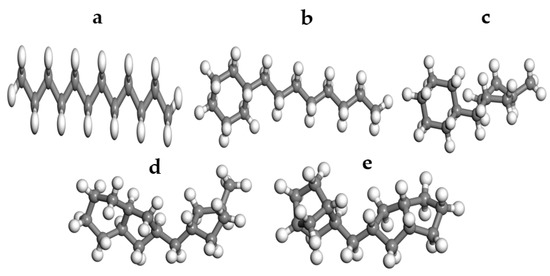
Figure 1.
Molecular model of naphthenic mineral oil: (a) Alkanes C12H26; (b) Monocyclic alkanes C14H28; (c) Bicyclic alkanes C13H24; (d) Tricyclic alkanes C16H28; (e) Tetracyclic alkanes C16H26.
2.2. Model of Oil-Water-Acid System
The saturated water content of transformer oil at room temperature is so low as to be in the magnitude order of ppm. The basic principle of molecular dynamics are to first solve the motions of atomic or molecular particles by Newton’s equation to obtain statistical mean values of microscopic parameters and then analyze the macro properties of multiple-molecule systems. If the number of water molecules is too small, the calculated parameters cannot represent substantial statistics. Accordingly, based on many simulation practices, the number of water molecules added into the transformer oil model is set as 20 to construct the oil-water system model.
The diffusion and distribution of water impurities in transformer oil rely on the MD simulation temperature of target thermodynamics. In long-term operation of the transformer, oil-paper insulation will continue to age and produce acids [24]. These acids mainly consists of low molecular organic acids, such as formic acid and acetic acid, and high molecular organic acids, such as stearic acid. In oil-paper insulation, low molecular organic acids majorly distribute in insulating paper, while stearic acid is mainly distributed in transformer oil [25,26]. In order to study the effect of aging acid on the diffusion behavior of water molecules, four oil-water-acid system models with different contents of aging acid were established by individually mixing 5~20 stearic acid (SA) molecules into the oil-water system model.
2.3. Simulation Methods
In molecular dynamics (MD) simulations, the energy of molecules is approximately described by the space coordinate function of each atom with a series of functions describing the relationship between atoms, which is called force field. A COMPASS force field is based on an ab initio algorithm to present the first high-quality molecular force field that unifies the parameters of organic and inorganic molecules. It is thus suitable to adopt a COMPASS force field for the multiple-molecule model and the dynamic simulations of a transformer oil mixture. For dynamics simulations, van der Waals force and Coulomb interaction are calculated by the atom-based summation method, with a cutoff distance of 15.5Å and a buffer width of 2.0 Å. Temperature and pressure controls adopts algorithms of Andersen and Berendsen, respectively. Newtonian equations of motion are solved by the Velocity Verlet jumping frog method.
Before the dynamics calculations, it is necessary to optimize the initial model to reach a stable conformation with the lowest potential energy, which is called geometry optimization of energy minimization, as implemented by the Forcite module of Materials Studio software package. A smart algorithm is used for geometry optimization to reach the energy convergence of 2 × 10−5 kcal/mol. The constant particle number, pressure, temperature (NPT) ensemble is used in MD simulations of an annealing model under atmosphere pressure, with temperature being gradually increased from 300 to 500 K and then decreased to 300 K in steps of 50 K. Consecutive heating and cooling processes are cycled five times.
The constant particle number, volume and temperature (NVT) ensemble is used to simulate each system model under a COMPASS force field for 5ps, with a time step of 1fs. The simulation trajectory is output every 250 fs to calculate the dynamic parameters. MD simulation temperature is set to 300 K, 500 K, and 700 K, respectively, to investigate the temperature influence on the displacement and diffusion of water impurities. Especially to compare different concentrations of SA molecules, the simulation temperature of oil-water-acid system was set to 343 K, which is the normal oil temperature of an operating transformer. Taking as an example for an oil-water-acid system, a thermodynamic equilibrium structure with a content of 20 SA molecules at 343 K is shown in Figure 2.
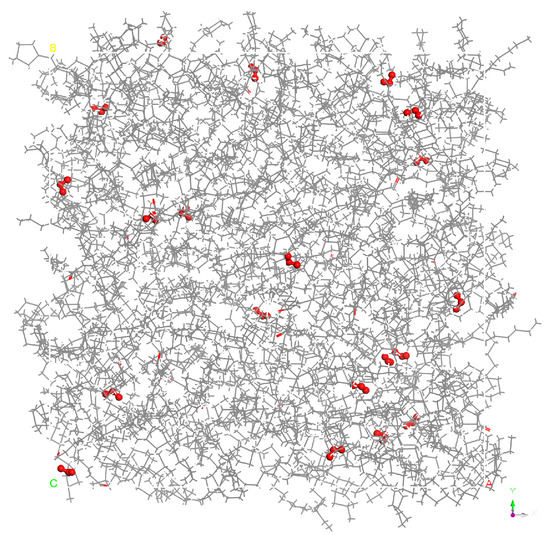
Figure 2.
Amorphous multiple-molecules model of oil-water-acid system with 20 stearic acid (SA) molecules at 343 K.
3. Simulation Results and Analysis
3.1. Diffusion Coefficient
In order to describe the displacement behavior of particles, the concept of mean square displacement (MSD) is introduced, which is defined by the average value of the square displacement of particles studied in a certain period of time:
where ri(t) and ri(0) represent the position vectors of molecule i at the initial time and t time, respectively, and brackets <> denote the average of the particles studied.
The diffusion coefficient is an important parameter that is used to characterize the diffusion ability of a substance in a medium. The larger the diffusion coefficient, the smaller the confinement effect of the medium on the diffusion particles. In molecular dynamics simulation, the data can be intercepted from the particle trajectories to calculate the mean square displacement, and then the diffusion coefficient can be obtained by the Einstein relationship as:
where n is the number of diffusing particles, and the differential can be approximately replaced by the slope a of MSD curves to calculate diffusion coefficient D = a/6. Twenty water molecules in each system model are incorporated for statistic calculations with Equation (2), according to the motion trajectory output from MD processes.
In the initial stage of thermodynamic simulation, the transient temperature of the system rises instantaneously to target temperature with an increment in entropy of molecules in the system. At this stage, the sharply increasing MSD curves imply that the displacements of water molecules have not converged into the stable thermodynamic equilibrium. Thus, the molecular system should be equilibrium for calculating the diffusion coefficient by the Einstein relationship, which means MSD increases linearly with time. Therefore, initial data before 500 fs in the MD process are discarded to obtain the linearly fitted MSD for calculating the diffusion coefficient, as shown in Figure 3. Table 2 and Figure 4 present the diffusion coefficients of various oil-water-acid systems.
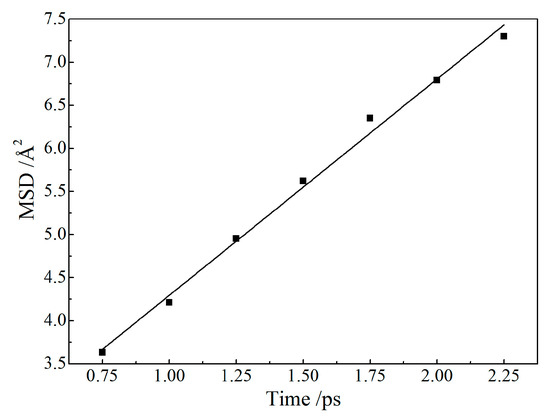
Figure 3.
Mean square displacement (MSD) of water molecules in an oil-water-acid system with 20 SA molecules at 343 K.

Table 2.
Diffusion coefficient for oil-water-acid systems.
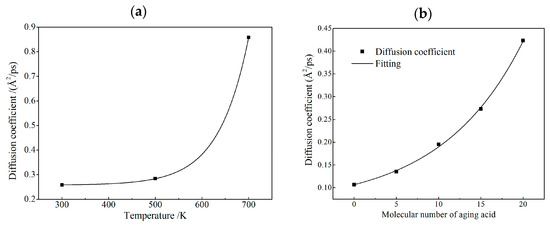
Figure 4.
Diffusion coefficients of water molecules in (a) oil-water system model at different temperatures; (b) oil-water-acid system model at different aging acid concentrations.
When the temperature of the oil-water system increases from 300 to 500 K, the diffusion coefficient of water molecules shows no evident change. By contrast, when the temperature rises from 500 to 700 K, the diffusion coefficient more than doubles to 0.86 Å2/ps. It is suggested from an effective fitting that the diffusion coefficient increases exponentially with temperature.
The relationship between the diffusion coefficient and temperature can be expressed by the Arrhenius equation as:
where D0 is the limiting diffusion coefficient, E is the diffusion activation energy, and R = 8.314 J/(mol·K) is the gas constant. The relationship between lnD and the reciprocal of temperature can be obtained with Equation (3) as lnD = −(E/R)(1/T) + lnD0, as shown in Figure 5. The diffusion activation energy can be calculated from the slope of the two straight lines. When the temperature of the oil-water system increases from 300 to 500 K, the diffusion activation energy decreases from 16105.99 J/mol to 579.97 J/mol, which indicates that water molecules in oil are more easily activated and have a stronger diffusion ability at high temperatures.
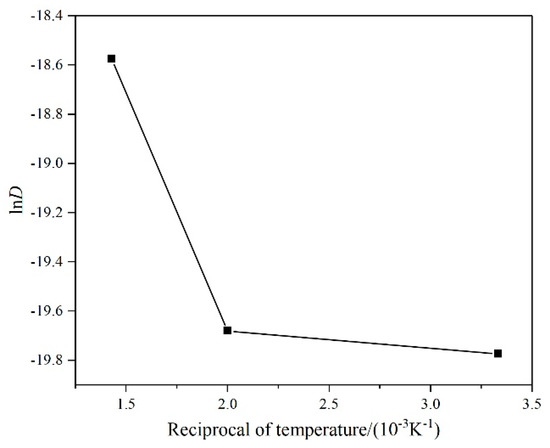
Figure 5.
The relationship between lnD and the reciprocal of temperature.
As shown in Figure 4b, the diffusion behavior of water molecules is greatly affected by SA concentration in the oil. As the number of SA molecules is raised from 5 to 20, the diffusion coefficient rises from 0.14 to 43 Å2/ps, implying that the presence of SA molecules will significantly promote water diffusion in oil. It can be reasonably speculated that the existence of SA molecules makes the molecular structure of transformer oil more loose, increases the free volume of water molecules in the oil-water system, and provides more space for the diffusion of water molecules.
3.2. First-Principles Electronic Structure Calculation
The electron properties of water molecules in the presence of nearby oil molecules are key factors in the electrical breakdown micro-process of transformer oil, and they determine the macroscopic breakdown characteristics of transformer oil containing water impurities. Due to the small amount of water molecules in the oil-water system model, the basic molecules of oil are evenly distributed around a single water molecule, and the contents of several basic alkane molecules are not very different. Therefore, In order to determine the localized electron state introduced by water molecules and the behavior of charge transports in oil, we built a simplified model of an oil-water system containing one water molecule and five basic alkane molecules of naphthenic mineral oil (as shown in Table 1) to feasibly simulate the local region comprising water impurities. After geometry optimization and molecular dynamics simulation, the stable configuration of the simplified model is shown in Figure 6. The densities of states (DOS) of the local area models for pure oil and oil-water systems are calculated by the atom-orbital all-electron first-principles method, as implemented with the DMol3 module of Materials Studio 8.0. Gradient correction functional (GGA) is adopted for DFT exchange-correlation functional, and self-consistent field (SCF) tolerance is set as 1 × 10−6 eV/atom in first-principles calculations. The calculation result of DOS is shown in Figure 7, with the highest occupied state (HOMO) being referenced as energy zero.

Figure 6.
Local region model of an oil-water system.
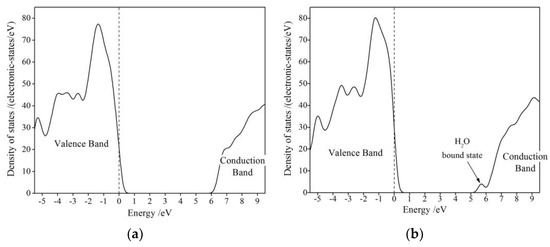
Figure 7.
Density of state for (a) pure transformer oil and (b) oil-water system in local region model.
Compared with DOS results for pure oil and oil-water systems, it is noted that the water molecule introduces a few unoccupied localized electronic-states (electron wave function is localized at the water molecule), with the energy levels being 0.4 eV lower than the conduction band bottom of transformer oil with a band-gap of 6 eV. The small DOS of these localized states from the water molecule is a manifestation of charge traps that capture electron carriers from the conduction band of the transformer oil. Therefore, the electrons injected from electrodes or thermally excited from the valence band of oil molecules are energetically favorable to transit from basic oil molecules to the impurity water molecule, but need to cross over the energy barrier in vacuum between oil and water molecules, which will drop off when water molecule thermally collides with an oil molecule. This electron trapping mechanism leads to a substantial probability of water molecules capturing electrons from oil to become water ions, and this will be accelerated to higher velocity under a high electric field to impact onto oil molecules.
Guan has reported the MD simulation study on the two-phase system of Dodecyl benzene (DDB) insulating oil with water ions, and demonstrated that the collision of water ions with DDB molecules under a high electric field will lead to the fracture of th eC-C bond and the C-H bond in the molecular chain, and produce unsaturated carbon fragments such as CH, CH3, C3H5, and C7H6 [27]. Accordingly, on the basis of the simplified model shown in Figure 6, we added the above unsaturated carbon fragments, one of each type, to build a simplized model of transformer oil with carbonized-fragments that are supposed to be the results of water ions impacting on oil molecules. The first-principles electronic-structure calculations of this carbonized oil model, as shown by DOS in Figure 8, illustrate that a few impurity bands, in a wide energy range from carbonized-fragments, are introduced into the band-gap of the transformer oil, through which electrons are estimated to be thermally excited by kT (k and T denote the Boltzmann constant and the temperature, respectively) from the valence and conduction bands of the transformer oil at ambient temperature.
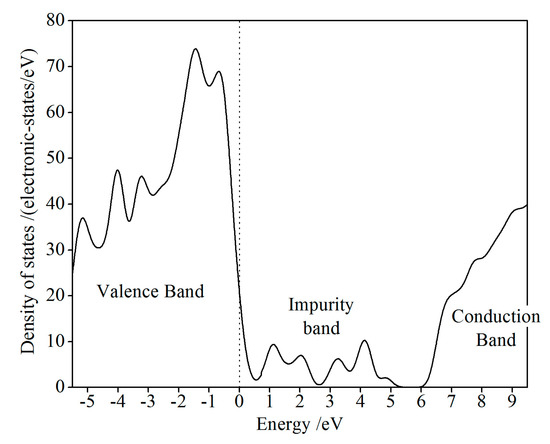
Figure 8.
Density of state for oil system with unsaturated carbonized-fragments.
The calculation of the electron density of the carbonized oil model is shown in Figure 9. It can be seen that the iso-surfaces of the carbonized-fragments and the oil molecule is connected together, which indicates that the electron wave functions of the two molecules overlap. The electrons in the conduction band and valence band of the oil molecule have a certain probability to cross the potential barrier of the vacuum molecular gap and transition to the carbonized-fragment. In summary, the carbonized components from the fracture of oil molecules will form a local conductive region in the transformer oil.
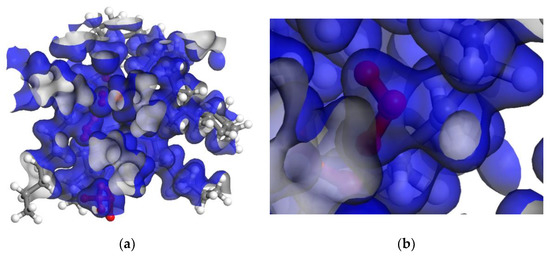
Figure 9.
(a) Iso-surfaces of electron density are indicated with blue, and the carboned-fragments are indicated with red; (b) partial enlarged detail near CH3.
3.3. Breakdown Mechanism of Transformer Oil with Water Impurities
The water molecules in transformer oil collide with oil molecules under thermal diffusion to capture electrons from oil molecules and transform them into water ions. But in the actual electric breakdown test, the electrons captured by the water molecules are preferred from electrode injection with a small amount of thermally excited electrons directly from oil molecules. Therefore, it can be inferred that the concentration of water ions in the high potential region of oil is higher. These water ions can obtain enough kinetic energy under an electric field to break the oil molecular chain and produce unsaturated carbon fragments, which form local conductive regions. Meanwhile, when the negative water ions reach the positive electrode, the charge exchange makes them revert to neutral water molecules. In the subsequent thermal diffusion process, water molecules will be converted into water ions, again due to collision and electron capture, thus repeating the migration process near the positive electrode.
With the continuous impact of water-ions under an electric field, the carbonized components generated in the high potential region are extending thermally from the high to the low potential area in oil, and finally form a conductive channel between two electrodes, after which a large amount of electrons will be injected from the electrode to cause an avalanche breakdown, with the conductive channel being rapidly expanded by electron bombardment. Therefore, the thermal diffusion of water impurities in oil and the migration of water ions under an electric field initialize the electric breakdown process of transformer oil. According to MD simulations of water-oil-acid systems, thermal diffusion of water molecules will be significantly exacerbated by the presence of aging acid; we have therefore elucidated the insulation fracture mechanism of transformer oil with water impurities in the longer-term operation that produces the aging acids.
4. Conclusions
The electrical breakdown mechanism of transformer oil that has water impurities and is used in long-term operation has been investigated by molecular dynamics simulations using first-principles electronic-structure calculations. The diffusion processes of water molecules in transformer oil with aging acid at different temperatures were dynamically simulated to evaluate the temperature and aging acid concentration that evidently affected the diffusion coefficient of water molecules in transformer oil. In first-principles calculations, a local area model of a water-oil system was used to theoretically reveal the electrical breakdown mechanism of transformer oil. Water molecules introduce unoccupied local states that capture electrons and transform them into negative water ions that will be accelerated to a high velocity and impact and break oil molecule chains, which can be aggravated by thermal diffusion of the water molecules. Carbonized components introduce impurity conduction mini-bands of electronic-states into the band-gap of oil molecules, which act as conductive regions that will thermally extend to form a conduction channel between electrodes. A large amount of electrons will be injected from the electrode into the conduction channel to discharge in an avalanche process of complete electric breakdown. For transformer oil containing water impurities, the thermal diffusion of water molecules and the high-velocity impact of water ions on oil molecules under a high electric field form conduction channels. Therefore, water impurities, which are expedited by aging acid in diffusion, play a role in initializing the electric breakdown process of transformer oil systems.
Author Contributions
Data curation and Formal analysis, B.C.; investigation and writing, J.-W.D.; project administration, M.-H.C. All authors have read and agreed to the published version of the manuscript.
Funding
This research was funded by the National Key Research and Development Program of China (2017YFB0902704), the National Natural Science Foundation of China (Grant No. 51877056 and 51677046).
Conflicts of Interest
The authors declare no conflict of interest.
References
- Wang, X.; Tang, C.; Huang, B.; Hao, J.; George, C. Review of research progress on the electrical properties and modification of mineral insulating oils used in power transformers. Energies 2018, 11, 487. [Google Scholar] [CrossRef]
- Lundgaard, L.E.; Hansen, W.; Linhjell, D.; Painter, T.J. Aging of oil-impregnated paper in power transformers. IEEE Trans. Power Deliv. 2004, 19, 230–239. [Google Scholar] [CrossRef]
- Zhou, L.; Yang, H.; Wu, G.; Wang, Y. Equilibrium moisture distribution in oil-paper insulation. High. Volt. Eng. 2007, 033, 27–30. [Google Scholar]
- Zhou, L.J.; Wu, G.N.; Liu, J. Modeling of transient moisture equilibrium in oil-paper insulation. IEEE Trans. Dielectr. Electr. Insul. 2008, 15, 872–878. [Google Scholar] [CrossRef]
- Akbari, A.; Dehpahlevan, S.; Borsi, H. Analyzing dynamic of moisture equilibrium in oil-paper insulation in power transformers for efficient drying. In Proceedings of the 2006 IEEE Conference on Electrical Insulation and Dielectric Phenomena, Kansas City, MO, USA, 15–18 October 2006; pp. 545–548. [Google Scholar]
- Liu, J.; Wu, G.; Zhou, L.; Luo, Y.; Huang, X. Dielectric frequency response of oil-paper composite insulation with transient moisture equilibrium. Proc. Csee 2013, 33, 171–178. [Google Scholar]
- Ekanayake, C.; Gubanski, S.M.; Graczkowski, A.; Walczak, K. Frequency response of oil impregnated pressboard and paper samples for estimating moisture in transformer insulation. IEEE Trans. Power Deliv. 2006, 21, 1309–1317. [Google Scholar] [CrossRef]
- Liao, R.; Yin, J.; Yang, L.; Gong, J.; Tang, C. Moisture content variation and transfer of oil-paper insulation durng thermal aging process. High. Volt. Eng. 2010, 36, 828–834. [Google Scholar]
- Liao, R.; Lin, Y.; Zhang, Y.; Xia, H. Independent effects of aged oil and aged paper on moisture evaluation of power transformers. Electr. Power Compon. Syst. 2016, 44, 1–9. [Google Scholar] [CrossRef]
- Liu, Y.; Lü, F.; Du, R.; Zhao, T. Study on dynamics of the bubble in transformer oil under non- uniform electric field. IET Sci. Meas. Technol. 2016, 10, 498–504. [Google Scholar]
- Zhao, T.; Lu, F.; Liu, Y.; Cheng, X.; Wang, F. Experimental study of cellulose particles effect on impulse breakdown in transformer oil. Trans. China Elctrotechnical Soc. 2018, 33, 1626–1633. [Google Scholar]
- Calcara, L.; Sangiovanni, S.; Pompili, M. Standardized methods for the determination of breakdown voltages of liquid dielectrics. IEEE Trans. Dielectr. Electr. Insul. 2019, 26, 101–106. [Google Scholar] [CrossRef]
- Rao, U.M.; Fofana, I.; Beroual, A.; Rozga, P.; Rapp, K.J. A review on pre-breakdown phenomena in ester fluids. IEEE Trans. Dielectr. Electr. Insul. 2020, 27, 1546–1560. [Google Scholar] [CrossRef]
- Miners, K. Particles and moisture effect on dielectric strength of transformer oil using VDE electrodes. Power Appar. Syst. 1982, 101, 751–756. [Google Scholar] [CrossRef]
- Krins, M.; Borsi, H.; Gockenbach, E. Impact of different water contents on the electrical strength of oil gaps and solid/liquid interfaces in the presence of carbon particles. In Proceedings of the 1999 IEEE 13th International Conference on Dielectric Liquids (ICDL’99) (Cat. No.99CH36213), Nara, Japan, 25–25 July 1999; pp. 281–285. [Google Scholar]
- Guo, C.; Chi, M.H.; Chen, Q.G.; Zhang, J.F.; Gao, Z.W. Breakdown Characteristics of transformer oil at low temperature in complicated voltage. High. Volt. Eng. 2019, 45, 492–498. [Google Scholar]
- Fukuda, M.; Kuwajima, S. Molecular dynamics simulation of water diffusion in atactic and amorphous isotactic polypropylene. J. Chem. Phys. 1998, 108, 3001–3009. [Google Scholar] [CrossRef]
- Zhu, M.Z.; Gu, C.; Chen, Y.F.; Liao, R.J.; Zhu, W.B.; Du, X.M.; Li, Z. Binding effect of insulating oil on water by molecular dynamics study. Csee Annu. Meet. 2013, 8, 1656–1663. [Google Scholar]
- Tian, W.; Tang, C.; Wang, Q.; Zhang, S.; Yang, Y. The effect and associate mechanism of nano SiO2 particles on the diffusion behavior of water in insulating oil. Materials 2018, 11, 2373. [Google Scholar] [CrossRef]
- Wang, W.; Dong, W.Y.; Jiang, D.; Ning, Z.Z. Water molecules migration at oil–paper interface under the coupling fields of electric and temperature: A molecular dynamics study. Mol. Phys. 2018, 117, 1–12. [Google Scholar] [CrossRef]
- Li, C.; Sun, Q.; Lv, Y.Z.; Wang, L.; Qi, B. Study of water molecules state in transformer oil via FT-IR spectrum and molecular dynamic simulation. In Proceedings of the 2017 IEEE 19th International Conference on Dielectric Liquids (ICDL), Manchester, UK, 25–29 June 2017; pp. 25–29. [Google Scholar]
- Zhang, T.; Xiao, X.; Li, Y.S.; Zhong, T.T.; Li, L.D.; Yang, W.Y. Molecular dynamics simulation of insulating oil under the interaction of water and acid. J. At. Mol. Phys. 2019, 36, 17–22. [Google Scholar]
- Theodorou, D.N.; Suter, U.W. Detailed molecular structure of a vinyl polymer glass. Macromolecules 1985, 18, 1467–1478. [Google Scholar] [CrossRef]
- Lundgaard, L.; Hansen, W.; Ingebrigtsen, S. Ageing of mineral oil impregnated cellulose by acid catalysis. Dielectr. Electr. Insul. IEEE Trans. 2008, 15, 540–546. [Google Scholar] [CrossRef]
- Hao, J.; Liao, R.; Yang, L.; Liang, S.; Tang, C. Analysis on the generation rules of both acids and copper products of transformer oil-paper insulation under thermal aging. High. Volt. Eng. 2010, 36, 2160–2166. [Google Scholar]
- Wu, G.; Cui, Y.; Duan, Z.; Wang, X.; Gao, B.; Li, W. Experimental study on further thermal aging of transformer oil-paper insulation. High. Volt. Eng. 2015, 41, 832–839. [Google Scholar]
- Guan, Y.; Chi, M.H.; Sun, W.F.; Chen, Q.G.; Wei, X.L. Molecular dynamics simulations of molecular diffusion equilibrium and breakdown mechanism of oil-impregnated pressboard with water impurity. Polymers 2018, 10, 1274. [Google Scholar] [CrossRef] [PubMed]
Publisher’s Note: MDPI stays neutral with regard to jurisdictional claims in published maps and institutional affiliations. |
© 2021 by the authors. Licensee MDPI, Basel, Switzerland. This article is an open access article distributed under the terms and conditions of the Creative Commons Attribution (CC BY) license (http://creativecommons.org/licenses/by/4.0/).